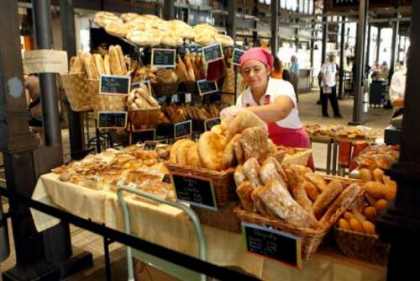At the Bakers - La Panadería
The history of bread in Spain goes back to the pre-Roman Celtiberians, who introduced it to the Iberian Peninsula in the 3rd Century BC.
Cereal cultivation in Mozarabic times was not extensive, but sufficient for bread to be part of the daily diet. The practice then was that the dough would be made at home and then taken to the public wood-fired ovens, where the baker would make a small charge to bake it.

Photo - www.efe.es
Bakers’ guilds, particularly on the Mediterranean coast, have existed in Spain for more than 750 years; there is written evidence of a guild in Barcelona in the year 1200.
Today, it is said there are more than 300 different types of bread in Spain. You won’t, however, find them all for sale at your local baker’s, the ‘panadería’.
The most common is the typical ‘barra’, which literally means ‘bar’, and is a slightly smaller version of the French baguette. You will also find baguettes on sale at the baker’s. A shorter version of the barra is ‘bocata’, which is used for making submarine-type sandwiches. Children take them to school for their ‘merienda’, or elevenses, perhaps drizzled with some olive oil before the filling is added. Butter is rarely spread on bread in Spain, although you may be offered it with toast and jam if you eat out for breakfast – ‘tostada con mermelada y mantequilla’.
Rolls are ‘bollos’ and sliced bread is ‘pan de molde’. Ask for ‘pan integral’ if you prefer brown bread.
There are dozens of varieties of rustic bread across the country. There is ‘chapata’ bread, which is similar to the Italian ciabatta. Cataluña has its ‘pa de pages’, or farmer’s bread, a round loaf with a thick crust which keeps the bread soft for longer. Andalucía’s version is ‘pan cateto’, peasant’s bread, a compact loaf which will also last for several days without going hard.
Galicia’s bread is ‘pan gallego’, which traditionally uses ‘masa madre’ – ‘mother dough’, as a starter. The traditional bread made in Cea, Orense, has a history which goes back for hundreds of years, and even has an annual fiesta in its honour.
‘Migas’ – ‘breadcrumbs’, developed as a poor man’s dish to make use of left-over rustic bread. It’s basically breadcrumbs or chopped up, stale bread, previously soaked in water or milk, which is fried in olive oil with garlic and some fatty jamón serrano. Other additions include peppers, chorizo and eggs. Torrox, in Málaga province, has its migas festival every December, when the local dish is prepared for everyone to enjoy.
